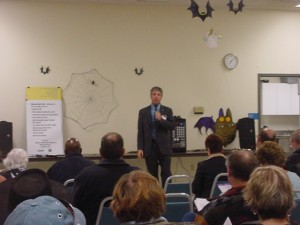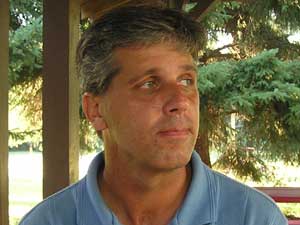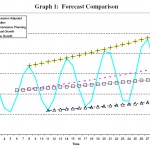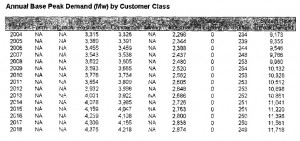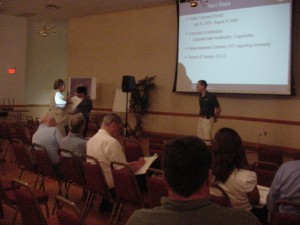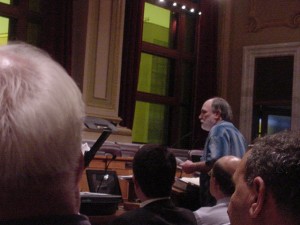Last night in Mazeppa
October 28th, 2009
Last night, Rep. Steve Drazkowski and Rep. Tim Kelly (who wasn’t there!) hosted a meeting about CapX 2o2o.
But Rep. Randy Demmer, 29A was.
As one person said, he had a “deer in the headlights” look as he sat in the front of the room. Did he have any idea what he’d be in for? I’d talked with him a bit when he came in, and he said he hadn’t heard from many constituents about CapX… oh… OK, well, we can do something about that! And it’s good he showed up to find out what was going on and hear the word on the streets and in the fields.
Short version of the meeting:
- Bill Glahn gets roasted for MOES “Minnesota_Resource_Assessment” report, which is utter crap, the report, that is… the roasting was well-deserved.
- PUC, Commerce, and DOT show up en mass and toady for process and project.
- Rep. Drazkowski utters words of placation, but did not promote Nov. 4 joint committee hearing on repeal of Minn. Stat. 117.19. HE’S ON ONE OF THE COMMITTEES, EARTH TO MARS!!!
- Affected landowners don’t buy it, they get that fundamentally CapX 2020 is not needed and are pissed-off at the crap (see above).
- CapX said they were not going through or around Rochester.
There were two things I let slide, can’t take on everything:
1.Their statements about Big Stone were odd, theywell knows that Big Stone could not interconnect without CapX, and I have the electrical studies which prove it, which after trying 5 times to make it work with a line to nowhere (Granite Falls) then assumed CapX in try #6… But I also wonder whether CapX Brookings (hence all of CapX) can go forward without Big Stone.
2. They kept saying “this is all about local load” and denying the LaX to Mad line, and kept talking about Rochester as the driver, yet they did not note, of course, the new gas plant at West Side sub or the four 161kV lines that are planned.
Overland’s Scorecard (concept stolen from Deb!):
CapX: 0
PUC: -5
DOT: 1
Commerce: -4
The People: +1
Longer version, bigger photo:
The people did a good job of expressing their displeasure and disbelief.
Bill Glahn brought up the Minnesota Resource Assessment Survey! Bad move… He got one of my awards for that Minnesota Resource Assessment Survey, and here’s Maccabee – Presentation to LEC 10/23/09 , another voice saying it’s outrageous. Last night Alan Muller got him good about it, told him” it was an unsatisfactory report, basically just a regurgitation of the business plans of MN… no independent thinking and not in the interests of the citizens of Minnesota …” Alan does have a way with words. When asked for a response Glahn looked abashed and admitted that he knows many people are unhappy with it. AS WELL HE SHOULD! I mean really… to use as an example that phony “chart” of Steve Rakow’s on p. 6:
… with no ID of meaning of X or Y axis, it’s deceitful, but they pulled that in CapX when faced with decreased demand, entering this chart, then citing its entry in the CapX 2020 Certificate of need record as if it means something. Oh, pleeeeeeeeze… We’re way below the 2004 actuals, and this forecast, for the Blue Lake expansion, it’s CapX 2020 era forecasts, we’re about 1,500MW down and growing, down 15% so far, down 2.5% in 1&2Q 2009, SEC 3Q filing and investor call due any second now will take it down further:
After last night’s meeting, Bill Glahn is certainly under fire, but I also got the feeling due to the cadre of state employees stumping for CapX, that it’s their perception that it’s in trouble. It could be something as simple as they have no financing to do it, that demand is so far down that it makes no sense even to PUC and applicants to build it, or … The DOT was distancing itself, there’s been a lot of pressure on DOT. The DOT has its “Policy of Accomodation” (at issue in Chisago Transmission Project III, or IV, the last round, where Xcel stuck poles, BIG poles, right in the middle of the new plan for US Hwy. 8, in one example, right next to and over a business), and here it is:
…and I don’t think they’re going to change that anytime soon. At the Legislative Energy Commission meeting in September, there was mention of an October 13 meeting with the DOT, but Dave Sykora, DOT, mentioned that was cancelled, and instead they met last week. There were no specifics disclosed, but the feeling I got from what was said was that it didn’t go the way legislators wanted it to, DOT didn’t cave. Legislators are looking, from Rep. Drazkowski’s statements last night, and from Rep. Westrom’s comments at the LEC meeting, for a way to do the project with minimal landowner pain. I don’t think that’s doable, and it’s sure not desirable. CapX 2020 is a project that shouldn’t be built, and if it is, it will cause considerable pain, for landowners, applicants and legislators!
Also noteworthy last night was the general failure to accept “need” and a high level of understanding, and for the most part, people are getting the broader picture. (there was an odd comment by Burl Haar that if there were questions about the appeal of the CapX decision, that they post most things on the docket, and to check with him!). So is the PUC’s argument that this belongs at the District Court, and not the Appellate Court (despite what Cupit says) on display in the docket for the world to see? I doubt it, but I’ll check.
Last night, Drazkowski kept referring to efforts to alter the eminent domain law, but he was evasive and didn’t disclose important info, like the upcoming November 4 hearing before Energy & Civil Justice (he’s on Civil Justice!) (Upcoming hearing on repeal of eminent domain exemptions), and he didn’t advise on how to advocate for change, dropped the ball, wouldn’t even pick it up.
Here’s the info on the hearing:
WEDNESDAY, November 4, 2009
10:00 AM
Joint Meeting of the Energy Finance & Policy Division and Civil Justice Committee
Room: 5 State Office Building
Chairs: Rep. Bill Hilty, Rep. Joe Mullery
Agenda: Informational hearing on HF1182 (Bly) Public service corporation exemptions repealed.
Anyone wishing to testify should contact Andy Pomroy at andy.pomroy [at] house.mn
Last night’s meeting in Mazeppa on CapX 2020 follows on the heels of one last Monday night in Chisago, about an 855MW gas plant proposed by LS Power, the Sunrise River Energy Station. Click here for Report on Monday Chisago meeting. They’ve proposed at least three gas plants before at that site, and they didn’t go far, this is the biggest, and most public, and will need mega transmission, BUT LS Power’s Blake Wheatley admitted at the Chisago meeting that they don’t have a plan, don’t have a PPA, don’t have anything but a tax exemption (est. $9-10 million) from legislators who should have known better than to sell out their constituents for nothing, and then after being caught, for a very small “Host Fee.” At that meeting, Mike Bull said Xcel won’t need any power for a long time, 2016-2017 (and if he’ll admit that at long last, we know it’s really a lot further out). As with last night’s meeting, at the Chisago meeting there was, despite heavy lobbying and presence of unions like IBEW and Building & Trades, a clear understanding that the LS Power plant is not needed, and that peak demand is down. Granted LS Power made the mistake of walking into an energy educated community, but even Bob Cupit was surpirsed by the turnout, said he’d never seen such a large crowd, ~500, standing room only in a hockey rink sized room (Also, FYI, Bob stated to the audience that “If citizens feel the system still failed to consider issues, the decision of the PUC can be appealed to the state Court of Appeals.“)
There is a theme. Minnesota doesn’t need more transmission, and we won’t, in the words of Xcel’s Mikey Bull, need an generation anytime soon. Am I paraphrasing correctly, Mike? (Duck & cover — the You Tube of that is forthcoming!!!) The MOES Minnesota_Resource_Assessment is a crock.
Here are the LEC members — it’d be good to contact all of them, and let them know what you think about “need” for generation and transmission, decreasing demand, and CapX 2020 in particular:
http://www.commissions.leg.state.mn.us/lec/members.htm
Here’s Senate member info:
http://www.senate.leg.state.mn.us/members/index.php?ls=#header
Here’s House member info:
http://www.house.leg.state.mn.us/members/hmem.asp
And about CapX and eminent domain, contact:
rep.steve.drazkowski [at] house.mn
rep.tim.kelly [at] house.mn
rep. randy.demmer [at] house.mn
Once more with feeling — Get thee to the House Energy and Judiciary Committee meeting:
WEDNESDAY, November 4, 2009
10:00 AM
Joint Meeting of the Energy Finance & Policy Division and Civil Justice Committee
Room: 5 State Office Building
Chairs: Rep. Bill Hilty, Rep. Joe Mullery
Agenda: Informational hearing on HF1182 (Bly) Public service corporation exemptions repealed.
Metachem meeting in Delaware City Tuesday
July 30th, 2009
Alan Muller, Green Delaware, questioning and commenting at the meeting
Tuesday night, there was a meeting in Delaware City regarding the “Standard Chlorine of Delaware, a/k/a Metachem Superfund Site.” This meeting was to gather comments on the “OU3 Proposed Plan.”
Here’s a link to the News Journal article about it — and the full story is below:
EPA: Metachem toxins will linger
Comments must be sent in by August 14, 2009, postmarked if mailed by that date, to:
thornton.hilary@epa.gov Hilary Thornton, Mailcode 3HS23 US EPA, Region 3 1650 Arch Street Philadelphia, PA 19103
****************************************
Here are my comments, sent just now:
Now, take a few minutes and work on yours!
****************************************
The way they handle these proceedings, it’s misleading and diversionary, a false, technical compartmentalization of the problem and solutions, which leads to a preordained, incomplete, and probably ineffective “clean-up.” Part of the problem is that it’s not clear that cleaning up is a priority. My impression is that they’re just interested in “dealing with it” in some way, the CHEAPEST way, checking off the “OU3 box” and moving on.
Their plan, their PREFERRED plan, is to cover it up and move on to “OU4.” Their “Preferred Plan” is, direct from their powerpoint slide 8:
2A. Surface Cap/Institutional Controls Impermeable Surface CapInstitutional Controls
- Cap materials TBD during Remedial Design Phase
- Cap materials and thickness would vary depending on future land use
Five-Year Reviews
- Future land use must not interfere with ongoing remedies
Est. $11.5 – 18.5 Million
- Required for any Superfund Site where contaminants remain
Why look! Imagine that! This is the CHEAPEST of the options. All options are “cap” crap, with “materials TBD” and, based on prior past bad experience with DNREC’s “hare-brained” ideas (yes, that’s a direct quote)for “beneficial use” and using coal ash and sewage sludge to cap the dump next to the river:
- I asked whether they’d use coal ash in the “TBD” cover material, and they would NOT commit to rejecting coal ash.
- I asked whether they’d use sewage sludge in the “TBD” cover material, and they would NOT commit to rejecting sewage sludge.
This is where that compartmentalization becomes a problem. They said that was not an issue for “OU3” and that it would be addressed in the “design phase.” Uh-huh, and the public is involved in that exactly HOW? And hello — WHAT the impermeable surface is has much to do with the appropriateness of using an impermeable cover. Rainfall on the impermeable cover will trickle off the cover over the edge, onto and into the ground, groundwater, etc. Even if it’s asphalt, that should be considered. Isn’t the EPA is in the process of addressing coal ash, and a rule pending?
Cost… Their “preferred” option 2A costs $11.5-18 million. The others?
The other options, from their powerpoint:
2B Surface Cap/ICs, with Soil Vapor Extraction Same surface cap and ICs as mentioned in 2A, plus an in Situ SVE system:2B Surface Cap/ICs, with ISTD Same surface cap and ICs as mentioned in 2A, plus in Sit thermal Desorption:
- Est. 200-500 air extraction wells at 50′ depth
- Treat contaminated air from beneath the cap
- treat off-gas from SVE system before discharge
- Additional sampling to identify “hot spots”
- Pilot study first, to test effectiveness
- Est. $19.1-20.2 Million
- Est. 2,800 heater and 1,400 heated vapor extraction wells, 8-12′ apart through 330,000 sq. ft. area
- Additional sampling to identify “hot spots” within 10′ of barrier wall
- Pilot study first, to test effectiveness
- Est. $92.8-99.8 Million
Let’s see… $11.5-18.5 v. $19.1-20-2 & $92.8-99.8. Doesnt’ take a rocket scientist to see that the cheapest “option” is “preferred,” and since when is cost the primary driver? Is this an indication of how they value those living here, drinking the water, breathing the air?
Oh, and did I mention they admitted, finally, that the contamination goes down at least 140 feet! That’s something they haven’t wanted to talk about before.
These options are the only ones looked at, the only ones that are under consideration.
CONSIDER THIS: One other option I want them to consider is to dig up part of the site, the cleaner part, and put a liner down there and take the contaminated dirt from the rest of the site and bury it there with the solid multi-layer liner, and then cover it.
Here’s an example of that in Minnesota, showing that it can and should be done. This is a scenario where it’s been sitting there since before the mid 70s, it has contaminated ground water in Lake Elmo and Oakdale, Minnesota. They’re using three layers of liner over packed clay and another three layers of plastic, plus sand with a collection and draingae system. In the Metachem case, they know groundwater is contaminated, that it’s seeping down, so what, short of this, will stop it? Take a look — Tom Meersman did a very good job on this:
History-making landfill do-over in Washington County
A win! HERC denied permit by Mpls Planning Commission
June 23rd, 2009
WE WON A SMALL WIN — A START ON PREVENTION OF EXPANSION OF HENNEPIN COUNTY’S HERC BURNER!
Now and then, it sure helps to win, and Neighbors Against the Burner is on a roll here!
Here’s Alan Muller, testifying about specifics, noting that the areas of greatest concentration shown in the “ballpark EIS” were NOT in the ballpark, and the City has not addressed these impacts in any way:
In the meantime, here’s his letter to the Commission prior to the last meeting with a graph showing emissions:
Rep. Karen Clark came in to testify about her opposition to the project, citing the impacts of pollution on Hennepin County, armed with graphic graphics showing how bad the situation is already, and testified about specific impacts in her district, the Phillips neighborhood, particularly arsenic impacts, and other harmful pollutants.
Rep. Frank Hornstein also testified against the project, as did John Schatz, Leslie Davis, and the most bizarre HERC cheerleading twit, Mary deLaittre, who has actually written THIS (be sure to check the links.. “unique waste to energy facilities, oh pleeeeeze, pass the barf bag)– PARAGRAPH BELOW IS LINKED TO SITE:
- A HERCulean effort
- Because repetition is our friend, we feel the need to re-visit HERC (Hennepin Energy Recovery Center) and extol its virtues again. We sense that many have been missing the forest for the trees with respect to our pal HERC. HERC is a neighborhood amenity that provides an invaluable community service by disposing of 356,000 tons of garbage a year for Hennepin County. This garbage is converted into enough electricity to power 25,000 households, or 1/5 of all the residences in Minneapolis. Not only is it a 24/7/365 powerhouse, it is also a green building, to boot. Powerful as it is, HERC could do even more. HERC’s operators cite the plant’s unused capacity, and desire to contribute additional steam/water heating and cooling for the North Loop neighborhood. Like any building over 20 years old, it needs a bit of updating. A proposed makeover by Hennepin County and Covanta Energy, originally designed by students from the University of Minnesota, shows how the building and grounds could be transformed. So, as a city that touts itself as being green and wanting to be more sustainable, we should be celebrating HERC and supporting its efforts to become a better neighbor and community landmark. Visit our expanded collection of images featuring unique waste to energy facilities from around the world.
I’m speechless… too bizarre…
And alsoin the bizarre category, Asst. City Attorney wrote an opinion as to the City’s authority to adopt more stringent air emissions standards, a blatant attempt to quash their desire to act, to LAWFULLY act:
It was a hoot that he cited, offpoint, from Jimmy Jam Harris’ tax case in Hennepin County — when I looked that one up, right below it was Terry Lewis’ tax case! I can’t imagine why he’d cite these cases, as they didn’t make a useful argument for his view of statutory interpretation or lack thereof…
Anyway, I had a few minutes to blast off a reply:
From the article about it in the STrib, and note they’re clear about their authority:
Here’s the full article:
